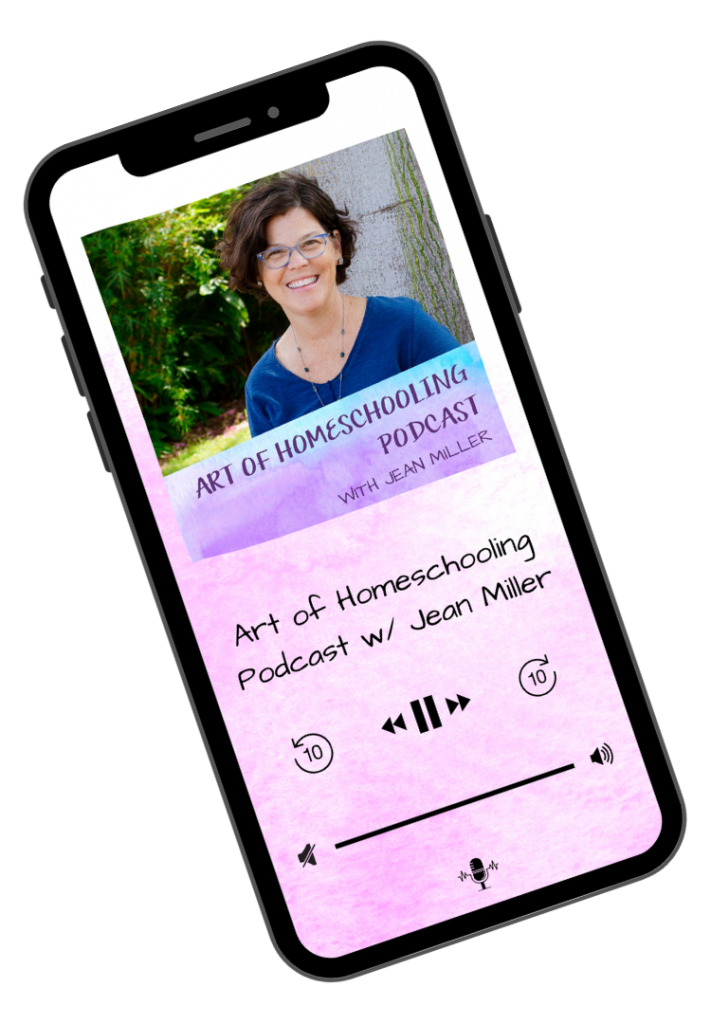Episode 105
In this episode of the Art of Homeschooling podcast, I bring you a simple, yet beautiful idea combining two of my loves: poetry and the outdoors! This idea is nature-inspired found poetry.
A found poem is created by collecting inspiring, beautiful, interesting words from anywhere and refashioning them into a poem. You get to play with the words, rearranging words, phrases, or quotes to create something new.
The words and phrases can come from existing texts – such as articles, speeches, letters, street signs, books, even other poems – or from your own recorded observations. These words are then shuffled around and re-ordered into a poem.
There are so many different ways to use this technique. For yourself or with your children. One of my favorites is to take a nature walk, record observations, and then create a collective poem from everyone’s experiences. Let’s jump in and I’ll tell you how!
Writing Nature-Inspired Found Poetry
Ever since I was a young girl, I’ve loved poetry. My favorite thing to do on a rainy day was to curl up on the couch with a book of poetry. That’s why I love to share this activity with others!
Here are 7 Simple Steps to Writing a Found Poem
1. Gather your materials for a nature walk. Each person needs a sketchbook and colored pencils. It’s fun for each to carry his or her own supplies along with a water bottle in a backpack.
2. Pick a nature trail to hike. Pack a snack or even lunch if you wish!
One Trail, Twelve Times: I love the creative idea to “hike one trail twelve times” that I heard from a local nature center. To go back and hike the same trail once a month for a year, collecting observations.
3. Once at the nature area, hike around for a bit and then find a “sit spot” – a place that looks inviting to sit for a while. Like a bench, boardwalk, log, or even on the ground. Each person can choose his or her own spot.
4. Sit in silence for a bit, observing. Then sketch some images from your spot. After drawing, use the opposite page to write down observations: words or phrases describing what you see, hear, smell, feel.
5. Finish your hike and then, once back at home, have everyone share their observations and pictures.
6. At this point, one person can collect all of the words and turn them into a poem. Or, the group can do this step together by putting the words and phrases on post-it notes or index cards so that they can be moved around to create the lines for your found poem.
7. And voila! A found poem. Don’t forget to give it a title.
I’ve done this in groups of all sizes, from two to ten. And the results are always delightfully surprising! Writing found poetry is fun to do with all ages, too. It’s even great with teenagers.
For some inspiration, listen to One Boy Told Me by Naomi Shihab Nye over on the Poetry Everywhere YouTube channel. This is a beautiful poem by one of my favorite poets consisting of words collected from things her young son said.
A Found Poem
And now, here’s a found poem created from the observations of seven children ranging in age from 7-10 on a fall October hike.
Woods in Fall
The ground is blanketed with leaves,
As we set out.
Leaves are fluttering down all around us,
Floating with the wind.
Gusty, a little chilly and cloudy,
More colors, more leaves than last time.
The rosy hue of crab-apples,
Among orange and yellow, golden and brown.
Leaves float downstream,
While others sink to the bottom like stones.
We find half-eaten acorns all over the ground;
And a squirrel exploring a log.
Looking up, we see a squirrel’s nest, a jumble of leaves
High up in the branches, falling apart now.
A rotting tree trunk, perhaps struck by lightning,
All full of bug holes and woodpecker holes.
Two squirrels play tag up a tree trunk,
While we sit and draw,
Where the boardwalk is slippery from rain
And decomposing leaves.
With a gust of wind, sticks fall, stems fall, and
Colorful leaves come raining down.
by the Children of Rainbow’s Edge
October 2010
I encourage you to give nature-inspired found poetry a try!
What is it about poetry that draws us in? Perhaps it’s the sparse words and pictures those words paint, just incomplete enough for us to add a bit of our own mental imagery.
And you can bring poetry and nature together in such a simple, beautiful way by writing some nature-inspired found poetry with your family.
Let me know how it goes!
Rate & Review the Podcast
If the Art of Homeschooling Podcast has inspired you, I’d LOVE it if you could rate and review the podcast on your favorite podcast player! Reviews can be left on Apple Podcasts (iTunes), Podcast Addict, or Stitcher.
Or simply pop on over to lovethepodcast.com/artofhomeschooling and choose where you want to leave your review.
And if you want to show your appreciation for the Art of Homeschooling Podcast, you can buy me a coffee!
Never Miss an Episode!


Check Out All the Episodes Here



